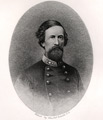Click Center Image for Full Size Picture
In the 1860s, Vicksburg, Mississippi, was strategically located along the Mississippi River (the river changed course in 1876). If the Union took the city, they would control the river, and Arkansas, Louisiana, and Texas would be separated from the rest of the Confederacy.
The citizens of Vicksburg first endured bombardment in 1862, but the major siege of the city occurred from May to July 1863. Union Major General Ulysses S. Grant commanded the forces besieging the city. Confederate Lieutenant General John C. Pemberton was given the duty of defending it.
John Cheney, who had reunited with his unit in June, settled down with them at Snyder's Bluff, Mississippi, along the Yazoo River north of Vicksburg. He described it for his wife in his June 12, 1863, letter. Cheney's unit never had to move closer to Vicksburg.
Grant, supported by Major General William T. Sherman, worked his siege strategy using troops on land and gunboats. He used frontal assaults, artillery bombardments, and even dug under the Confederate earthworks to place explosives. The Confederate soldiers and civilians trapped in Vicksburg dealt with dwindling supplies of food and ammunition, frequent bombardments, and disease. Pemberton realized that he was outdone and surrendered on July 4, 1863, a day after the Union victory at Gettysburg. Vicksburg did not celebrate the Fourth of July again until the mid-1940s, while in the midst of another war—World War II.
indeed. . . . The Yazoo is inhabited principally by Crockodiles [sic] which may be seen at any time."
Snyder's Bluff, Mississippi.









